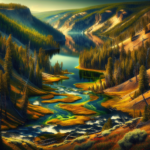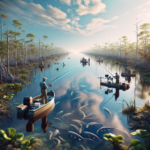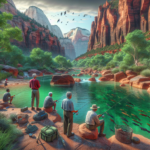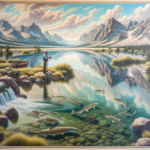Fishing in the Badlands National Park: Rivers and Reservoirs
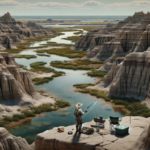
Introduction
Did you know that the Badlands National Park, known for its dramatic landscapes and rich fossil beds, also offers some of the most unique fishing opportunities in the United States? Whether you’re an avid angler or a casual fisherman, the rivers and reservoirs in and around the Badlands provide a diverse array of fishing experiences. This article will guide you through the best fishing spots, techniques, species, and seasonal considerations to make your fishing trip to the Badlands National Park a memorable one.
In this comprehensive guide, we will cover the historical and geographical context of fishing in the Badlands, delve into specific fishing techniques, provide detailed information on the species you can expect to catch, and offer practical tips and best practices. Additionally, we will discuss essential gear, safety and conservation practices, and planning your trip, ensuring you are well-prepared for your adventure.
Understanding the unique fishing opportunities in the Badlands National Park is crucial for anyone looking to explore this hidden gem. Whether you’re aiming to find the best fishing spots, master a new technique, or simply enjoy the natural beauty of the area, this guide has you covered.
Background/Context
Historical or Cultural Significance
The Badlands National Park, located in South Dakota, has a rich history that dates back thousands of years. The area was originally inhabited by Native American tribes, including the Lakota Sioux, who relied on the land’s resources for sustenance. The park’s name, “Badlands,” comes from the Lakota phrase “mako sica,” which means “land bad.” This term was used to describe the rugged terrain and harsh conditions of the area.
Fishing has been a part of the local culture for centuries, with early settlers and Native Americans relying on the rivers and streams for food. Today, fishing in the Badlands continues to be a popular activity, attracting anglers from all over the country.
Geographical Overview
The Badlands National Park spans over 244,000 acres and is characterized by its striking geological formations, including deep canyons, towering spires, and expansive prairies. The park’s climate is semi-arid, with hot summers and cold winters, making it essential to plan your fishing trips according to the season.
The park is home to several rivers and reservoirs, including the White River, Sage Creek, and the Cheyenne River. These water bodies provide diverse habitats for various fish species, making the Badlands a unique fishing destination.
Key Points/Details
Fishing Techniques
Technique Overview
Fishing in the Badlands can be approached using several techniques, including fly fishing, spin fishing, and baitcasting. Each technique offers its own set of advantages and is suited to different conditions and species.
When and Where to Use
Fly Fishing: Ideal for targeting trout in the clear, fast-moving streams of the Badlands. The best spots for fly fishing include the White River and Sage Creek.
Spin Fishing: Versatile and effective for catching a variety of species, including bass and catfish. Spin fishing can be done in both rivers and reservoirs.
Baitcasting: Best suited for larger fish species found in deeper waters, such as the Cheyenne River. This technique is particularly effective during the warmer months when fish are more active.
Recommended Gear
- Fly Fishing: 5-6 weight fly rod, floating fly line, and a variety of dry flies, nymphs, and streamers.
- Spin Fishing: Medium-action spinning rod, 6-10 lb test line, and a selection of spinners, crankbaits, and soft plastics.
- Baitcasting: Medium-heavy baitcasting rod, 10-20 lb test line, and a range of jigs, swimbaits, and topwater lures.
Species Information
Species Overview
The Badlands National Park is home to a variety of fish species, each with its own unique habits and preferred habitats. Some of the most common species include:
- Rainbow Trout: Found in the clear, cold waters of the White River and Sage Creek. These fish are known for their acrobatic fights and are a favorite among fly anglers.
- Largemouth Bass: Common in the warmer, slower-moving waters of the Cheyenne River and local reservoirs. These fish are aggressive and provide a thrilling challenge for anglers.
- Channel Catfish: Often found in deeper waters and are most active during the warmer months. These fish are known for their size and strength.
Best Practices
To successfully catch these species, consider the following tips:
- Rainbow Trout: Use small, natural-looking flies and focus on areas with clear, fast-moving water. Early morning and late evening are the best times to fish for trout.
- Largemouth Bass: Use lures that mimic the bass’s natural prey, such as frogs and minnows. Fish near structures like submerged logs and weed beds.
- Channel Catfish: Use strong-smelling baits like chicken liver or stink bait. Fish in deeper waters during the day and shallower areas at night.
Location Information
Top Fishing Spots
The Badlands National Park offers several prime fishing locations:
- White River: Known for its clear waters and abundant trout population. Access points are available at various locations along the river.
- Sage Creek: A smaller stream that offers excellent fly fishing opportunities for trout.
- Cheyenne River: A larger river that is home to a variety of species, including bass and catfish. The river has several access points and amenities for anglers.
Regulations and Licenses
Before fishing in the Badlands, it’s essential to be aware of local regulations and licensing requirements:
- All anglers aged 16 and older must have a valid South Dakota fishing license.
- There are specific catch limits and size restrictions for different species. Be sure to check the South Dakota Game, Fish, and Parks website for the most up-to-date information.
- Some areas may have seasonal restrictions or special regulations, so always check local guidelines before fishing.
Seasonal Considerations
Seasonal Variations
Fishing conditions in the Badlands can vary significantly throughout the year:
- Spring: As water temperatures rise, fish become more active. This is an excellent time for trout fishing in streams and rivers.
- Summer: Warm temperatures can make fishing challenging during the day. Early morning and late evening are the best times to fish.
- Fall: Cooler temperatures and lower water levels make for excellent fishing conditions. This is a great time to target bass and catfish.
- Winter: Fishing can be slow due to cold temperatures, but hardy anglers can still find success in deeper waters.
Best Times to Fish
The optimal times for fishing in the Badlands are:
- Early Morning: Fish are most active during the cooler hours of the day.
- Late Evening: As temperatures drop, fish become more active again.
- Spring and Fall: These seasons offer the best overall fishing conditions.
Events and Tournaments
Event Overview
While the Badlands National Park itself does not host fishing tournaments, several nearby communities and organizations hold annual events:
- South Dakota Governor’s Cup: A popular fishing tournament held on Lake Oahe, just a few hours from the Badlands.
- Black Hills Fly Fishing Expo: An annual event that features workshops, demonstrations, and competitions for fly anglers.
Preparation Tips
To prepare for these events, consider the following tips:
- Practice your casting and fishing techniques in advance.
- Ensure you have all necessary gear and supplies.
- Familiarize yourself with the event rules and regulations.
Tips and Best Practices
General Tips
- Always check local weather conditions before heading out.
- Bring plenty of water and snacks to stay hydrated and energized.
- Respect local wildlife and practice Leave No Trace principles.
Avoid Common Mistakes
- Not checking local regulations: Always ensure you are aware of and follow local fishing laws.
- Using the wrong gear: Make sure you have the appropriate gear for the species and conditions.
- Fishing at the wrong time: Plan your fishing trips for early morning or late evening for the best results.
Advanced Techniques
- Match the Hatch: Pay attention to local insect activity and use flies that mimic the current hatch.
- Structure Fishing: Focus on areas with natural structures like logs, rocks, and weed beds where fish are likely to hide.
- Drift Fishing: Use the current to your advantage by allowing your bait or lure to drift naturally with the flow of the water.
Gear and Equipment Recommendations
Essential Gear
- Fishing rod and reel appropriate for your chosen technique.
- Fishing line suited to the species you are targeting.
- A variety of lures, baits, and flies.
- Tackle box with essential tools like pliers, line cutters, and hooks.
- Fishing license and any required permits.
Optional Gear/Upgrades
- Waders for fishing in streams and rivers.
- Polarized sunglasses to reduce glare and see fish more clearly.
- Fish finder or depth finder for locating fish in deeper waters.
- Portable cooler for keeping your catch fresh.
Where to Buy or Rent
You can purchase or rent fishing gear from several local shops and online retailers:
- Cabela’s: Offers a wide range of fishing gear and equipment.
- Bass Pro Shops: Another excellent option for purchasing fishing supplies.
- Local Outfitters: Several local shops near the Badlands offer gear rentals and sales.
Safety and Conservation
Safety Tips
- Always let someone know your fishing plans and expected return time.
- Wear appropriate clothing and sun protection.
- Be aware of local wildlife and keep a safe distance.
- Carry a first aid kit and know basic first aid procedures.
Conservation Practices
- Practice catch and release to help maintain fish populations.
- Use barbless hooks to minimize harm to fish.
- Dispose of fishing line and other waste properly.
- Respect local regulations and protected areas.
Planning Your Trip
Accommodations
There are several accommodation options near the Badlands National Park:
- Cedar Pass Lodge: Located within the park, offering cabins and campsites.
- Badlands Inn: A nearby hotel with comfortable rooms and amenities.
- Local Campgrounds: Several campgrounds in the area provide a more rustic experience.
Travel Tips
- The Badlands National Park is accessible by car via Interstate 90.
- The nearest major airport is Rapid City Regional Airport, approximately 70 miles from the park.
- Consider renting a car for flexibility in exploring different fishing spots.
Additional Activities
In addition to fishing, the Badlands National Park offers several other activities:
- Hiking: Explore the park’s numerous trails and enjoy stunning views.
- Wildlife Viewing: The park is home to bison, bighorn sheep, and prairie dogs.
- Photography: Capture the park’s unique landscapes and wildlife.
Frequently Asked Questions (FAQs)
Do I need a fishing license to fish in the Badlands National Park?
Yes, all anglers aged 16 and older must have a valid South Dakota fishing license.
What are the best times of year to fish in the Badlands?
The best times to fish are during the spring and fall when temperatures are cooler, and fish are more active.
Can I rent fishing gear near the Badlands National Park?
Yes, several local outfitters offer gear rentals and sales.
Are there any fishing tournaments in the Badlands?
While the park itself does not host tournaments, nearby communities hold annual events such as the South Dakota Governor’s Cup.
Conclusion
Fishing in the Badlands National Park offers a unique and rewarding experience for anglers of all skill levels. With its diverse fish species, stunning landscapes, and rich history, the Badlands is a must-visit destination for any fishing enthusiast. By following the tips and best practices outlined in this guide, you’ll be well-prepared to make the most of your fishing adventure in this remarkable national park. So pack your gear, get your fishing license, and head to the Badlands for an unforgettable fishing experience.

